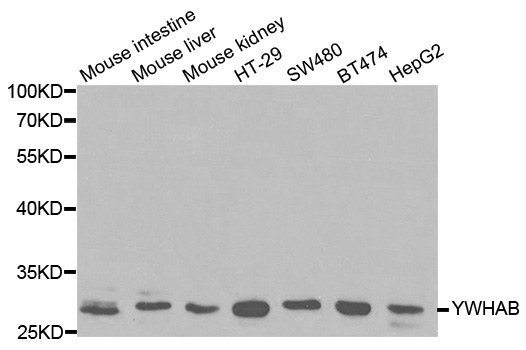14-3-3 beta (YWHAB) Rabbit Polyclonal Antibody
USD 436.00
USD 823.00
USD 436.00
Specifications
| Product Data | |
| Applications | ELISA, ICC/IF, IHC, IP, WB |
| Recommended Dilution | WB,1:500 - 1:2000 IHC-P,1:50 - 1:100 IF/ICC,1:50 - 1:200 IP,0.5μg-4μg antibody for 200μg-400μg extracts of whole cells ELISA,Recommended starting concentration is 1 μg/mL. Please optimize the concentration based on your specific assay requirements. |
| Reactivities | Human, Mouse, Rat |
| Host | Rabbit |
| Isotype | IgG |
| Clonality | Polyclonal |
| Formulation | Buffer: PBS with 0.09% Sodium azide,50% glycerol,pH7.3. |
| Concentration | lot specific |
| Purification | Affinity purification |
| Conjugation | Unconjugated |
| Storage | Store at -20℃. Avoid freeze / thaw cycles. |
| Stability | Stable for 12 months from date of receipt. |
| Predicted Protein Size | 28kDa |
| Gene Name | tyrosine 3-monooxygenase/tryptophan 5-monooxygenase activation protein beta |
| Database Link | |
| Background | This gene encodes a protein belonging to the 14-3-3 family of proteins, members of which mediate signal transduction by binding to phosphoserine-containing proteins. This highly conserved protein family is found in both plants and mammals. The encoded protein has been shown to interact with RAF1 and CDC25 phosphatases, suggesting that it may play a role in linking mitogenic signaling and the cell cycle machinery. Two transcript variants, which encode the same protein, have been identified for this gene. |
| Synonyms | GW128; HEL-S-1; HS1; KCIP-1; YWHAA |
| Reference Data | |
| Protein Families | Druggable Genome |
| Protein Pathways | Cell cycle, Neurotrophin signaling pathway, Oocyte meiosis |
Documents
| Product Manuals |
| FAQs |
| SDS |
{0} Product Review(s)
Be the first one to submit a review






























































































































































































































































 Germany
Germany
 Japan
Japan
 United Kingdom
United Kingdom
 China
China




